
Atlas Obscura
Postcard auto-generates content from this account to provide the most up-to-date info from the web.


Atlas Obscura
Postcard auto-generates content from this account to provide the most up-to-date info from the web.

Majorcan restaurant · el Raval
"Barcelona is positioned on the Mediterranean Ocean, but its culinary influences come from a variety of places, including inland Spain. For a cuisine that’s even more overtly Mediterranean, it’s necessary to head to the Balearic Islands. If your visit to Barcelona doesn’t allow time for the ferry ride, consider a meal at Na Mindona. Located in Raval, Barcelona’s immigrant neighborhood, this tiny restaurant specializes in the cuisine of Mallorca, the largest of the Balearic Islands. Although Barcelona is the mainland point with the most connections to the islands, Na Mindona is one of only a scant handful of places in the city that serves some of these dishes. The ever-changing chalkboard menu at Na Mindona has something of a dual nature. On the one hand, there’s an emphasis on offal-forward dishes such as callos amb herbes, tripe braised with herbs; frit mallorquí, fried cubes of offal with peas and potatoes; and llengua am taperes, pork tongue braised with capers. But you’ll also find several vegetable dishes such as tomàtiga de aregada, a salad of bitter escarole topped with a mix of minced tomatoes, salted sardines and pickled sea fennel, and tumbet amb du, ratatouille-style layers of potato, eggplant, peppers, tomato, herbs, topped with a fried egg. If you can’t decide, opt for pa amb oli, Mallorca’s famous spread of toasted bread, rubbed with tomatoes and topped with things that can include sausages such as sobrassada, grilled vegetables or cheese. Herbs, olive oil and bright Mediterranean flavors are a throughline, and there’s also vegetable-stuffed pies, Mallorcan sausage, and crisp, mineral Mallorcan wines. When they’re delivered on time, this is one of the few places on mainland Spain where you can find ensaïmades, Mallorca’s distinctive snail-shaped pastries. Although their origins are disputed—some have attributed them to Sephardic Jewish bakers, while others believe credit goes to Moors—but nowadays, they’re synonymous with the Balaerics. Either way, over the centuries, the recipe has evolved to incorporate an ingredient that is neither kosher nor halal: lard, which gives these coils a particularly light texture. Know Before You Go The menu at Na Mindona changes frequently, although some dishes make regular appearances." - linkogecko, Austin Bush
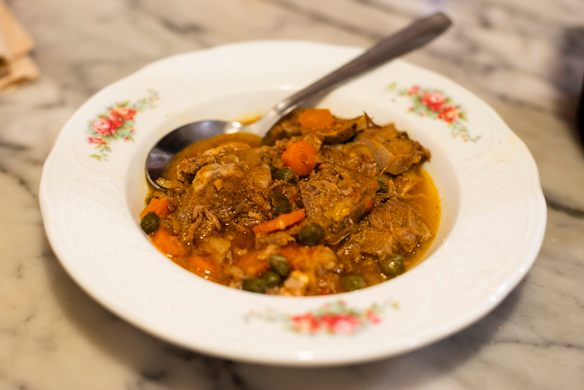
Cheese shop · la Vila de Gracia
"Spain’s Catalonia region has a noble and diverse cheesemaking legacy, with unique cheeses ranging from mató, a cottage cheese often drizzled with honey and eaten at dessert, to tupí, a product made from leftover bits of cheese that have been fermented in a clay pot with booze. Barcelona was largely absent from this legacy until 2019, when Italian former veterinarian and self-professed “super lover of cheese” Francesco Cerutti opened Pinullet. Claiming to be the only cheesemaker in Barcelona, Cerutti uses organic milk to produce as many as nine different varieties of cheese right in the city center. Every Monday, Cerutti receives a shipment of 1,000 liters of raw milk from a farm with three cows in Cardadeu, a village 40 kilometers northeast of Barcelona. Come Tuesday, the largely self-taught cheesemaker might turn this into a fresh cheese such as queso fresco, a couple Italian-style pasteurized cheeses such as mozzarella or ricotta, and three to four raw milk aged French-style cheeses such as a Camembert- or a Tomme-style cheese. He also produces yogurt and cheeses seasoned with ingredients ranging from truffles to chilies. Cerutti’s so-called “cheese laboratory” spans a workroom, refrigerators for aging cheese, and a shopfront, where he also sells a few bottles of wine and other products, in addition to those cheeses. These days, he sells the bulk of what he produces to local restaurants. Know Before You Go Tuesday is cheese-making day at Pinullet, and Francesco is happy to allow visitors to view the process." - Austin Bush
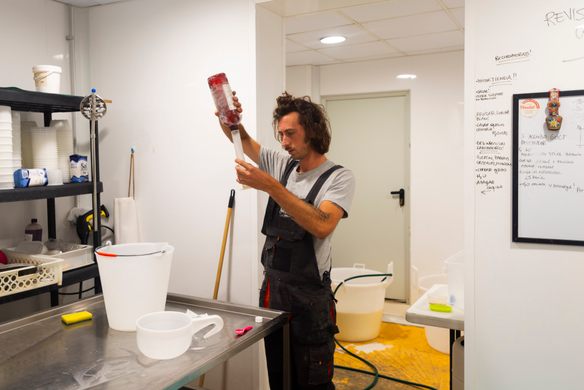
Chocolate shop · Barri Gotic
"When the Spanish encountered cacao in Mexico in the early 16th century, Barcelona became an important transit point for the ingredient when it arrived in Europe. But xocolata, as processed chocolate is known in Catalan, didn’t become mainstream in the city until a couple hundred years later. Eventually, the ingredient came to be included in dishes both savory and sweet, and Barcelona gained a strong reputation for both its chocolate consumption and production. In particular, Carrer Petritxol, in the city’s Gothic Quarter, became home to several chocolate shops, lending the narrow lane the nickname of “Chocolate Street,” a history described via tile murals that line it. Arguably the most famous of these is Granja Dulcinea, opened in 1941. Generations of locals have come here to drink xocolata a la tassa, Catalan-style hot chocolate, dark and rich—almost chocolate mousse-like—but milkier and less thick than elsewhere in Spain. If this isn’t enough, opt for the decadent suís, the “Swiss,” hot chocolate topped with a mountain of rich whipped cream, or you can pair your mug with the dense, sugar-dusted churros—perfect for dipping. The interior is charmingly decked out in dark woods, there’s a fireplace and a small upper balcony, and all the servers are men. They also serve a variety of baked goods including ensaïmadas, a pastry of Sephardic Jewish origin from Mallorca that’s common in Barcelona. Know Before You Go Like many businesses in Spain, Granja Dulcinea closes for a siesta between 1 p.m. and 4:30 p.m." - Austin Bush
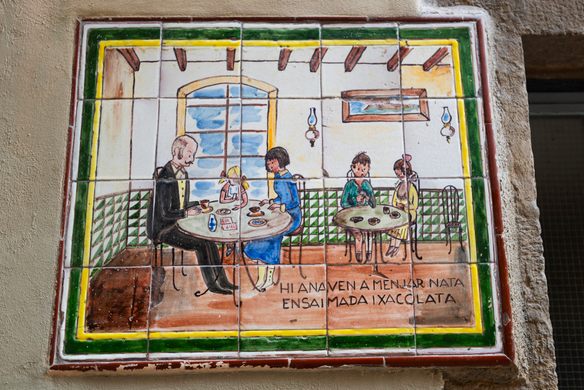
Restaurant · el Poblenou
"In Spain, going to the beach is as much about eating as it is about sunbathing. As such, most beaches have chiringuitos, semi-open-air beachside bar-restaurants specializing in seafood dishes. Barcelona is no exception to this, and with several sandy beaches within the city limits, the city is home to several xiringuitos, as they’re known in Catalan. Head north from the portside La Barceloneta neighborhood, and you’ll encounter a string of sandy urban beaches. Platja del Bogatell, one such strip, is backed by Xiringuito Escribà, arguably the city’s most famous beachside restaurant. It opened in 1992, and has a strong reputation for its rice-based dishes. Although paella and other Spanish rice dishes are largely associated with Valencia, further south, Catalonia has its own variants, some of which are served at Escribà. Arroz negro is rice dyed black with cuttlefish ink and studded with chunks of cuttlefish, while Catalan-style paella is served with a mix of seafood and meat known as mar i muntanya. And there’s also fideuà, a paella-like dish made from thin noodles, served with a tiny mortar of aioli. In all these cases, the centerpiece carbs are prepared and served in paella pans, reduced until just short of crispy, with rich, concentrated, salty flavors. Although Escribà is semi-open-air—with the flies to prove this—the dining room retains a rich aroma of reducing seafood broth, and the station where workers prepare as many as eight paella pans is fun to watch. If rice isn’t your thing, you could try the Iberian Ham Airbag, a massive puffed bread topped with slices of cured ham, and the sangría here is said to be better than most. Know Before You Go Although more than 30 years old, Xiringuito Escribà remains popular; book in advance." - Austin Bush
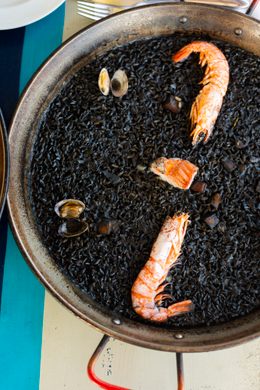
Coffee shop · Oxford
"The Queen’s Lane Coffee House in Oxford, England, claims to be the oldest continuously run coffee house in Europe. It sure is old, having been established in 1654 by a Levantine Jew from Syria named Cirques Jobson, though it has only been located on the present site since (circa) 1970. There is another claimant to the title in Oxford, the Grand Café on High Street, which was originally founded in 1650, a coffee house opened by a Jewish entrepreneur named Jacob. It is Europe’s oldest in that aspect, but technically speaking, it has not continually been a coffee house throughout its history unlike the Queen’s Lane Coffee House. During the 18th century, when the Queen’s Lane Coffee House was named Harper’s Coffee-House, philosopher Jeremy Bentham founded the modern concept of utilitarianism here. Know Before You Go The coffee house is open seven days a week." - Fred Cherrygarden
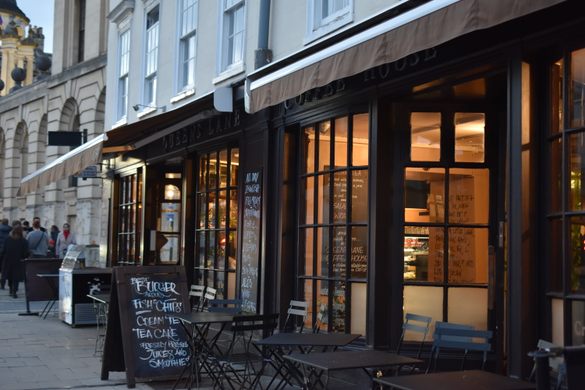
Catalonian restaurant · la Vila de Gracia
"In the old days, a bowl of Cheerios wouldn’t have cut it. If you were a laborer in Barcelona in the early 20th century, you would likely have begun the day with an esmorzar de forquilla, or “fork breakfast.” The term refers to hearty, heavy, meaty breakfasts typically paired with wine. Many of the places in Barcelona that used to serve esmorzar de forquilla have closed, but a few cling to the legacy. Every morning, from 9 a.m. to noon, Cal Boter, in the working-class Gràcia neighborhood, opens its doors to those who need a bit more to start off their day. A chalkboard menu spans dishes such as braised oxtail, tripe or pig trotters with snails, grilled lamb chops, baked salt cod with aioli, stewed pork cheeks and other dishes that would have the brunch crowd running in the opposite direction. Starters include the ubiquitous basket of bread and a simple but delicious salad of sweet onions bathed in olive oil, and sides include French fries or beans. (Esmorzar de forquilla generally doesn’t include rice, pasta, rice or soup.) This is breakfast, so yes there’s coffee, but even more so, there’s wine, served in a porró, Catalonia’s iconic glass vessel that negates the need for a glass. Cal Boter, which dates back to 1986, has a classic feel via hand-painted tiles and vintage ads. The long space extends to a cozy dining room illuminated via skylights. These days, there aren’t so many laborers in Gràcia, and esmorzar de forquilla customers might include an older generation of locals, perhaps reading the newspaper with a porró, and the odd tourist. Know Before You Go Cal Boter’s “fork breakfast” is available from Monday to Saturday, from 9 a.m. to noon." - Austin Bush
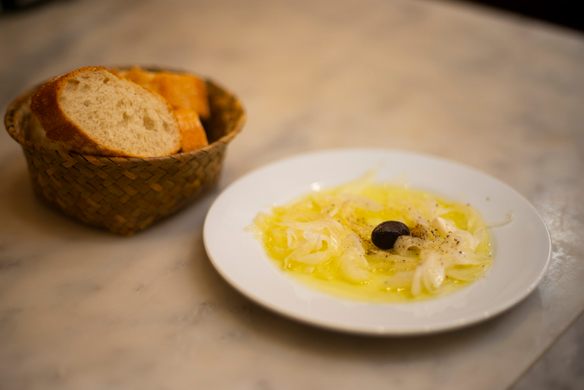
Catalonian restaurant · Barri Gotic
"Can Culleteres is Barcelona’s oldest restaurant, opened in 1786. Its interior reflects this age via faded murals, bright Portuguese-style tiles, and signed portraits of famous guests. Yet ask a native of Barcelona about the restaurant, and it’s likely he or she will conjure up a pasta dish. Trade with Italy and later an influx of Italian laborers meant a longstanding culinary exchange between Catalonia and Italy. One of the most iconic examples of this is canelons, a Catalan take on cannelloni, and a beloved Christmas dish in the region, typically made with leftover meats. Today, the dish is arguably the most iconic menu item at Can Culleteres, and it takes the form of long pasta tubes stuffed with a savory mix of veal and pork, buried in a béchamel that’s been seasoned with a generous hit of nutmeg, and topped with pleasantly charred Emmental cheese. First served at the restaurant in the 1950s, the pasta dish is now its best seller, with as many as 300 sold on a Sunday. The restaurant is also known for another iconic Christmastime pasta dish: escudella: Served on Christmas day, the soup starts with a ham bone broth that’s supplemented with snail-shaped pasta known as galets, four different types of meat—perhaps chunks of veal and/or finely chopped minced butifarra sausage—and garbanzo beans, carrots, potatoes, and cabbage. Other traditional dishes sold at Can Culleteres include emblematically Catalan combinations of fruit and meat such as ànec guisat amb prunes, duck braised with prunes, and mel i mató, local cottage cheese drizzled with honey and topped with walnuts. Know Before You Go The set menus, which range from a tapas spread to share to a seafood-centric feast, offer solid value for money. Reservations are essential." - Diana Hubbell
Cafeteria · el Raval
"It’s Barcelona, in the late 19th century, and you’re craving a glass of milk. Where do you go? Most likely you’ll head to a granja. In Catalan, the word means “farm,” but it also eventually came to refer to businesses that sold milk, typically with cows on-site. M. Viader, founded in 1870, is one of Barcelona’s oldest granjas. It’s also one of the city’s most progressive. Realizing the sanitary downsides of having cows in their increasingly urban backyard, the early owners bought a farm at the city’s edge, and created a small factory that made cheeses and other dairy products that could be brought into the city. As such, they were forerunners of milk preservation and packaging, and in 1931, they created Cacaolat, allegedly the world’s first bottled chocolate milk, a product sold across Spain today. Today, M. Viader retains an Old World feel with ancient floor tiles and vintage furniture and signage; the plaque out front indicates that it’s been recognized by the city for these elements. They serve what many consider Barcelona’s classic crema Catalana, Catalonia’s silky cousin to crème brûlée. The dish takes the form of a rich, sweet custard, made aromatic by the addition of lemon zest, and topped with a burnt sugar crust. Friendly staff will coach you through the process of breaking the glassy crust with your spoon and taking a spoonful that includes both the custard and those crispy shards. Another Catalonia-specific item available here is mel i mató, cottage cheese served drizzled with honey and topped with walnuts. Know Before You Go Like many businesses in Spain, M. Viader closes for a siesta between 1:30 p.m. and 5 p.m." - Diana Hubbell
Catalonian restaurant · la Vila de Gracia
"Chicken paired with lobster; veal meatballs braised with cuttlefish; rice dishes that blend shellfish and chicken: these are some of the most classic examples of mar i muntanya, a style of Catalan cooking that blends proteins from the sea and the land. Although a hallmark of Catalan cuisine, these dishes are getting increasingly harder to find, especially in Barcelona. But at La Pubilla, a restaurant in the city’s Gràcia neighborhood, the tradition lives on. Originally opened in 1912, nearly a century later La Pubilla was taken over by chef Alexis Peñalver and today is considered a reference for modern Catalan cuisine. The restaurant’s lunchtime menu includes a mar i muntanya de la setmana, “surf and turf of the week,” typically a dish rooted in this Catalan tradition but with a contemporary tweak or two. Recent examples include terrina de peu i morro amb pop i parmentier, a terrine of pig face and foot—a Catalan specialty—seared until crispy, and served on a bed of mashed potatoes, garnished with chunks of tender octopus; and panxeta rostida amb calmars i ceba confitada, roast bacon with squid and confit onions. The mar i muntanya is always present on La Pubilla’s excellent value set lunch, along with other dishes that tend to revolve around offal or other off-cuts – the emphasis being on cuina catalana & de mercat, “Catalan & market cuisine,” convenient given that it’s located directly across from Mercat de la Llibertat. It’s also one of a dwindling number of places in Barcelona that continues to serve esmorzar de forquilla, “fork breakfast,” essentially a hearty, meaty way to start the day. None" - Diana Hubbell
Tapas bar · la Barceloneta
"Even if you’ve been to Barcelona’s portside La Barceloneta neighborhood, you probably didn’t notice this spot. But that’s not your fault; La Cova Fumada, one of the city’s most iconic bodegas, has no sign. Inside, there’s little more to indicate that this is a restaurant—at least not in the contemporary sense: the walls are decorated with a few pages torn out of a soccer magazine. There’s an ancient menu posted on the wall and a few wine barrels off to the side. Little seems to have changed here since opening day in 1944. Yet most likely the place is filled with people: locals, tourists, fancy Barcelona chefs. Look closely, and you’ll notice that all of them are eating a particular snack. This is the bomba, or “bomb,” a deep-fried, golf ball-sized globe of mashed potatoes with a minced meat center. To serve, a bomba is topped with a dollop of rich, garlicky aioli. You’ll be asked if you want picante, an additional dollop of a spicy sauce (you do). It’s crispy, creamy, rich, meaty and just barely spicy. Just how that incredibly thin, crispy exterior manages to retain the soft pillowy center is a mystery of cooking and science. The bomba was allegedly invented here, but has since spread across Barcelona and Spain. La Barceloneta is located at the edge of the city’s port, and is an old fisherman’s neighborhood, which means that in addition to bombas, La Cova Fumada serves seafood. Scan that old wall-mounted menu for options and prices; most go for calamars, pan-seared squid, pulpo, tiny braised octopus, or bunyols de bacallà, battered and deep-fried salt cod. Alternatively, the menu also spans heartier dishes such as stews and bean dishes, and the kitchen also has a solid reputation for mushroom dishes, when in season. Know Before You Go La Cova Fumada both operates at odd hours (it closes at 3 p.m. most days) and is incredibly popular, which means that it’s necessary to get there early—around 11 a.m. or so." - Diana Hubbell